L.A. County Outlook
Hot home sales fuel record tax roll
July 25, 2013

As home sales boom, at least for now, the county's property tax roll is hitting new heights. Photo/L.A. Times
As Los Angeles’ housing market recovery moves from anemic to heated, county coffers are reaping the benefits of a record-setting, nearly $1.130 trillion property tax roll—more than $50 billion bigger than last year’s.
But thousands of homeowners whose taxes went down when the assessed value of their properties plunged during the recession are catching an upward wave, too. That means higher tax bills for 196,200 property owners, who’ll be forking over an average of $820 more in property taxes this year.
The rise in values isn’t universal: some 121,800 properties that declined in assessed value are staying at the same level this year, while 50,600 properties are experiencing further reductions.
But overall, the trend is positive, with this year’s 4.66% increase in the county tax rolls representing a marked improvement from the 1.49% and 2.24% increases in the previous two years. The upswing reflects a hot market for real estate in many parts of the county, with once dismal home prices rebounding in a big way.
“Strength in the residential real estate market was the largest single factor for the increase in roll value,” Chief Deputy Assessor Santos Kreimann said in a statement.
Assistant Assessor George Renkei added: “In addition to closing the roll at a new record level, we are proud of the accuracy of this year’s forecast as well as the other substantial improvements that were developed and implemented over the past twelve months.”
Even as “SOLD!” increasingly replaces “Bank-owned” or “Foreclosure” on local real estate signs, there are limits on how much a rising market can help the county’s bottom line. Under Prop. 13, property tax increases are tied to the Consumer Price Index and capped at 2%. Most of the time, it’s an uphill progression that allows the county’s tax roll to grow even when individual home prices are in the doldrums. But it’s a testament to how bad things were during the recession that in 2010, the CPI entered negative territory, posing interesting questions for the Assessor’s Office. It had to determine whether, by the law, property assessments would stay level or reflect the CPI’s dip. After consulting with the state Board of Equalization, the assessor granted a .237% reduction to all the eligible properties in the county. Since then, the adjustments have been in positive territory: less than 1% in 2011, 2% in 2012, and 2% again this year.
Property taxes represent a major part of the county’s budget, and the 4.66% increase that pushed the roll to its highest level ever this year translates to an estimated $180 million more in the county’s general fund.
Such increases are welcome news for the county’s budget—but small potatoes compared to the potential infusion that the county will realize when thousands of properties that haven’t changed hands in decades eventually are sold and their values adjusted to current market levels.
Prop. 13 rolled back property assessments to 1975-76 levels until a property is sold, when the new value is allowed to adjust upward. While the vast majority of L.A. properties have changed hands at least once since 1981, 362,710 of them haven’t, representing 19% of the parcels in the county, according to an analysis by the county’s Chief Executive Office. The “stored value” in those properties represents a potential multimillion dollar infusion for the county’s general fund when they’re sold in the years to come.
Posted 7/25/13
New law serves up a cottage industry
July 18, 2013
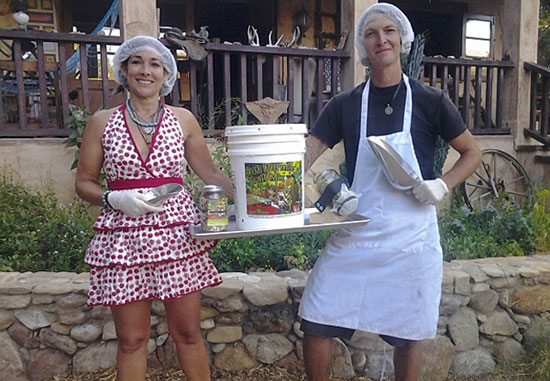
Lisa Cianci and Ben Lawson of Ant Permie's are among hundreds taking advantage of the Homemade Food Act.
Gene Holmon’s spice mix was so good that his Woodland Hills family urged him to sell it. Jessica Schnyder learned to make jam and pickles from her Hollywood chef friend, Amanda Carr.
Kyle and Liz von Hasseln, grads of Southern California Institute of Architecture, were playing with a three-dimensional printer one day when they realized they could make sugar sculptures. Shantal Derboghosian, a Van Nuys engineer, was unemployed when she discovered a gift for baking. Ben Lawson perfected his organic, sustainable trail mix in Topanga when he wasn’t drumming for a Long Beach punk/grind-crust band.
Until about six months ago, few, if any, of them could have profited much from their passions. But today, they and hundreds of others are part of an entrepreneurial boomlet ignited by a new state law allowing Californians to make food for sale from their home kitchens.
The California Homemade Food Act, which created a new category of food production called “cottage food operation,” has been in effect since January and, according to health officials, few places have seized on it with the excitement of Los Angeles County.
Spurred by L.A.’s creative culture and California’s artisanal food movement, a home-based underground of bread makers, cookie bakers, coffee roasters, marshmallow puffers, marmalade canners, baklava peddlers and just about every other imaginable kind of food purveyor has come out from behind the stove to pull permits.
“Our numbers are very high compared to other jurisdictions,” says Director of Environmental Health Angelo Bellomo, who notes that, so far, more than 500 applications have been filed with the county for permission to prepare and sell non-perishable food products at home rather than in expensive leased space in certified commercial kitchens.
Of those, he says, about 200 have been approved; most of the rest are awaiting payment of annual fees ranging from $103 to $254, depending on whether the business is direct sale only or includes sales through restaurants and markets. (Click here and here for the most recent list of permit holders.)
“There’s been a lot of interest on the part of those who have always dreamed of having a home enterprise.”
The development is no surprise to Mark Stambler, a Los Feliz artisan baker whose naturally leavened organic French bread sparked the state law in 2011 after it started flying off the shelves in local cheese shops and restaurants.
“I was selling a good number of loaves each week, and as long as I kept my head down, no one was the wiser,” says Stambler, whose bread was baked in his backyard in a wood-fired stone oven.
But over time, his bread became the talk of foodie L.A., and the Los Angeles Times ran a story, telling readers where they could find it. Within 24 hours, he says, county health inspectors descended on the shop where his goods were being sold and informed customers that it was illegal to sell food that hadn’t been prepared in a commercial kitchen.
Stambler responded with an 18-month crusade to open the system, with the help of his local state legislator, Assemblyman Mike Gatto (D-Silver Lake). The new law applies only to “non-potentially hazardous food” such as bread, preserves, dried foods and other goods whose ingredients don’t include meat, cream or other perishable items. It requires home food producers to complete a course in food processing and the labeling of their products. Those who want to sell their wares in bakeries, markets and restaurants also must undergo a kitchen inspection.
But even with the law’s limitations, the activist baker—who says he lost two-thirds of his business after the county crackdown—says he’s been thanked repeatedly for pushing the changes.
“I’ve heard from people all over the state, saying they really needed this for the added income,” he says.
The cottage food option was certainly helpful for Shantal Derboghosian, who coped with a spell of joblessness by opening Shakar Bakery out of her one-bedroom apartment in Van Nuys. Specializing in custom cakes (her business name is Armenian for “sugar”), the 31-year-old environmental engineer found herself spending six to eight hours on her creations—a labor of love if it’s in your own kitchen, but a hefty bite out of your bottom line if you have to pay an hourly rate for a commercial workspace.
“I was renting kitchen space,” she says, “but they were charging about $25 an hour and it was expensive. My first official client was a three-tier baptism cake for 150 people, with a lot of sculpting—it was a nautical thing, with whales and waves and little anchors.”
Her current project is a 5-foot-tall, flashing tribute cake modeled on the French techno-music duo Daft Punk that she created with the help of Garen Khanoyan, a fellow engineer whose day job is at the Jet Propulsion Laboratory. “These things aren’t quick to do,” she notes.
Neither is building a business, Kyle and Liz von Hasseln say, noting that the new rules have bought them crucial time to scale their custom sugar sculpting business, The Sugar Lab.
The couple says their concept was born in 2010, when they were architecture students at the Southern California Institute of Architecture downtown and a friend announced it was her birthday. “Our thesis at SCI-Arc was on new developments and free-form fabrication, which is the catchall phrase for 3-D printing,” says Kyle von Hasseln. “We were living in a teeny little apartment in Echo Park and we didn’t have an oven. So we decided to try to 3-D print her a sugar cake topper for her birthday cake.”
The idea took months of trial-and-error, he says, but eventually it yielded an extraordinary manufactured sugar sculpture that has since led to a series of custom assignments for birthday parties and weddings in collaboration with a local bakery. Their latest project? A stunning 3-D sugar diamond, done on spec for GLAAD, celebrating the U.S. Supreme Court’s same-sex marriage decision.
“We could invest in commercial kitchen space, but it would be hard for young entrepreneurs just out of grad school with a lot of debt,” he says.
For many artisans, however, the cottage food permits are simply a chance, at last, to see whether their ideas have a market.
“We love food and want to have our own business,” says Schnyder, a 26-year-old Mar Vista restaurant manager who has teamed with her 29-year-old friend Carr to launch Calliope Canned Commodities, a sideline she says expresses their enthusiasm for jams, pickles and Victorian circus musical instruments.
“What we make requires such a slow process and such small batches that you don’t need a lot of space to do it, Schnyder says. “But until now, we haven’t been able to sell it. We’ve just given it away to our friends.”
For Lawson, the drummer, the cottage food program has been a way to market not only his Ant Permie’s trail mix but also his belief in sustainability, local trade and emergency preparedness.
“We all know of local cafes that serve, you know, brownies that some old lady made in an apartment that are so good that nobody drops a dime on them,” he says. “Now that kind of thing can be legal.”
His signature organic snack is made at Cross Bull Ranch, the permaculture collective and retreat where he lives in Topanga, and is sold in airtight, rodent-proof, 5-gallon buckets that, depending on storage conditions, can keep food fresh “for months to years.”
As for Gene “Cappy” Holmon and his wife Paulette, the law has provided an answer both to those who have clamored over the years for his secret Cappy’s Dry Rub spice mix and to the retired couple’s own prayers.
“We had played with the idea for years,” says Paulette, a former costume designer. “Then this law passed, and the Heavenly Father just told us one day, ‘You guys should do something with it’.”
“Everybody seems to like it,” marvels Gene, a 66-year-old disabled veteran and retired small business owner. “Hey, we don’t play golf, so we’ve got to do something, right?”
Posted 7/18/13
For Hollywood, no splendor in the park
April 5, 2013
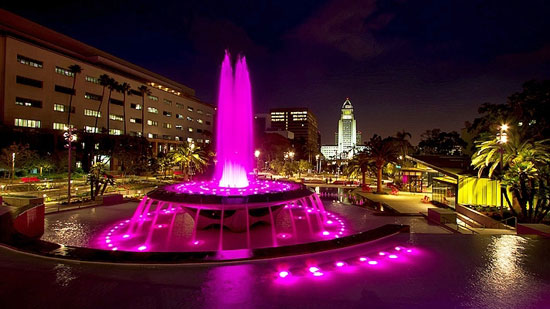
The scene at Grand Park, where film executives have complained about high fees. Photo/Shabdro via Flickr
Lucas Rivera had barely gotten his feet wet in Grand Park’s beautifully restored fountain when Hollywood came calling. Sony’s Screen Gems told the park’s newly named director that it wanted to use the Arthur J. Will Memorial Fountain in a scene for an upcoming remake of the romantic comedy “About Last Night.”
But what studio executives say they heard from Rivera last fall was no laughing matter. The price to film in L.A’s hippest new green space was $20,000 for each of the park’s four blocks—the steepest fee for any publicly-owned venue in Los Angeles.
Lucas, who was swamped with planning the park’s gala grand opening at the time, says the request “came at us out of nowhere.” The filmmakers repeatedly insisted on lower rates but Lucas says there was nothing he could do because the fees had been formally set by the county. Already committed to the location, the studio grudgingly paid the $20,000. But that was only the first act of a civic drama that, for months, has pitted county officials against their hometown industry.
Since October, the cost of filming in Grand Park has become a cause célèbre among location scouts, labor leaders and studio representatives, who’ve publicly challenged the county’s commitment to keeping entertainment jobs in the Los Angeles region. Screen Gems is the only studio so far to pay Grand Park’s high price of admission. In interviews and in testimony before the Board of Supervisors, industry officials have argued that the high film fees at Grand Park and such famous county-owned venues as the Hollywood Bowl, Walt Disney Concert Hall and the Los Angeles County Museum of Art are contributing to the long-running exodus of Hollywood jobs to more film-friendly locales in the U.S. and abroad.
“These are iconic Los Angeles County landmarks and we are turned away from filming them due to high fees or rules that seem designed to discourage production companies to even consider approaching them rather than embracing this cornerstone industry that helped create part of the rich history that is Los Angeles,” Teamsters official Ed Duffy, who represents location managers, complained to a receptive Board of Supervisors last October. The board ordered a review of the controversial rates by the Chief Executive Office.
On Tuesday, the board is expected to vote on a new permit structure for Grand Park proposed by the county CEO in the wake of the industry’s complaints. The proposed rates have been slashed by 74%, but the fees are still prohibitively high for a public park, industry representatives insist. The county says its goal is to strike a balance between the economic needs of the entertainment business and the park’s primary purpose as a place “first and foremost for the community to enjoy.”
Rivera understands Screen Gem’s case of sticker shock and acknowledges that the initial rates didn’t achieve the right balance, which he mostly attributes to the park’s growing pains.
“We’re young, we’re going to make some bad choices,” Rivera says. “But this is a learning process. With all the people involved, we’re going to get it right…My main concern has been to program the park and make it a destination place for Angelenos.”
So far, he seems to be succeeding.
The park, with its unique cityscape surroundings and dramatic view of City Hall, has been widely praised for its programs, from noontime yoga sessions to a weekly farmer’s market to a presidential election-night viewing party broadcast live by CNN. The CEO says the park, which is managed by the Music Center, attracted more than 19,000 visitors during its first six months of operation and has established 53 programming partnerships.
Entertainment industry representatives say they fully respect that the county’s No. 1 priority is to make the park a hit with the public.
Philip Sokoloski of Film LA, a nonprofit organization that coordinates and processes film permits, says industry executives “realize the park is for public enjoyment first…They don’t want to displace other activities and uses. They just want to make sure they aren’t priced out of the park.”
Some fee critics, though, even question the county’s rationale, noting that even under the new pricing structure, it would cost $12,000 to rent all four blocks of Grand Park between the overnight hours of 9 p.m. and 9 a.m.
County officials say they based the original and revised rates on those charged by other high-end venues here and across the country, including the Huntington Library in San Marino, a private nonprofit institution that charges $11,000 a day, and the Hollywood Bowl, which costs $17,000 to rent. But industry representatives argue that Grand Park’s pricing should be in line with more comparable county venues, including Descanso Gardens and the Los Angeles County Arboretum and Botanic Garden, which charge daily rates of between $1,500 and $6,400 and are often used for film shoots.
Dawn McDivitt, who oversaw Grand Park’s construction for the CEO’s office and continues to play a key role in its operation, says she hopes the new rates will be approved by the board on Tuesday. She knows that some entertainment industry officials still will be unhappy, but she says the county will evaluate the program in six months. Nobody in the county, she says, is ready to say the issue is a wrap.
“We’ll look at the experience we’ve gained from having filming in the park and its impact on the public we want to serve,” McDivitt says. “It’s all an evolving process.”
Posted 3/21/13
Annual report comes alive
March 1, 2012

The county's latest Annual Report has gone digital, with user-friendly videos and social networking tools.
If the words “Annual Report” make you reach for the snooze button, has L.A. County got a wake-up call for you.
For the first time ever, the county’s Annual Report is being presented in a user-friendly digital format that features county leaders—from the Board of Supervisors to the Treasurer-Tax Collector—speaking directly to the public in short, informative videos. Feel like talking back? Each segment includes an array of contact information for getting in touch with county departments, and is also readily shared on Twitter, Facebook and other social media platforms.
Updated 7/11/12: The League of American Communications Professionals recently recognized the county’s Annual Report in its 2011 Vision Awards with five honors, including a Platinum Award for the best large government report. The international contest drew 5,500 entries from 24 countries.
One of the report’s most distinctive features is a series of videos produced by the LA County Channel, including a piece on Melinda Star Guido, the world’s third-smallest baby, born at County-USC Medical Center last year.
You might call it an annual report for the YouTube generation. But it also includes all the substance the county has traditionally provided, including a downloadable print version, complete with pie charts on the county budget.
“In past years we only had a paper report and printed just a few thousand copies,” David Sommers, the county’s acting director of public affairs, said in a statement. “That’s a fraction of the copies needed for a potential audience of 10 million county residents, or even our own 90,000 employees.”
Check out the county’s 2011 Annual Report here.
Posted 3/1/12
New program keeps junked boats at bay
October 20, 2011
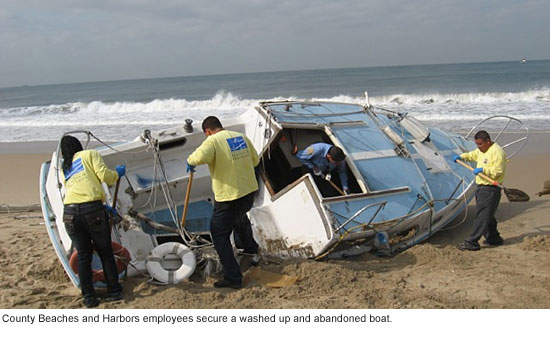 As the economy flounders, a new Los Angeles County program will soon be sending a message to boaters: Please don’t abandon ship.
As the economy flounders, a new Los Angeles County program will soon be sending a message to boaters: Please don’t abandon ship.
Abandoned boats have become a vexing problem in the past several years as owners unable to sell or maintain their vessels give up and walk away from them, sinking them in local harbors, ignoring them until they break from their moorings or allowing them to rot in their slips.
“People get into boating thinking it’s going to be inexpensive,” says Deputy Bryan White of the Los Angeles County Sheriff Department’s marine operations division. “But nothing about boating is inexpensive.”
And abandoning a boat just passes on the costs to the public at large.
“We have to move it out of harm’s way so that it’s not a public nuisance, then we have to store it, then we have to go through a long process to find the owner and do a lien sale auction if the owner doesn’t’ show up,” says county Director of Beaches and Harbors Santos H. Kreimann.
If the boat has been sunk, as many are—usually after being stripped of identification—there’s the cost of retrieval and environmental mitigation. Most of the time, he says, the boats are in such bad shape by the time they’re found that they’re simply stripped and crushed, again at public expense.
Meanwhile, each boat represents four to six months or more of work for public employees. The typical abandoned boat costs taxpayers about $5,000 in staff work and another $2,000 to process the lien sale, Kreimann says.
“It’s become a worsening problem,” he says. Last year, according to the Sheriff’s Department, the county disposed of 24 abandoned boats that had been left in the marina, sunk in local waters or allowed to wash up on county beaches, but authorities expect that number to rise to 30 or more this year.
For some time, the county has underwritten the cost of the problem with grants from a state fund earmarked for the abatement of abandoned recreational watercraft. This year, however, the county is also tapping into a second state program to encourage owners to voluntarily turn in their vessels before they reach the point of abandonment.
The pilot Vessel Turn-In Program, or “VTIP”, allows owners to surrender unwanted boats without any penalty if they’re thinking of walking away, says Denise Peterson, boating law enforcement manager for the state Department of Boating and Waterways, which administers both programs.
The idea, she says, is to save money on the boat disposal by retrieving more boats from slips, rather than from underwater or public beaches, where the retrieval and storage can be up to ten times more costly and much more complex.
“The marinas usually know who’s delinquent on slip fees, or soon-to-be delinquent,” she says. “This program allows them to reach out to these owners and say, ‘Don’t worry, you’re free and clear, let us take care of it. It saves a lot in administrative costs.”
This week, the Board of Supervisors approved a $1,700 county match requirement for a $17,000 grant that will allow Los Angeles County to launch a VTIP program this year. A second vote enabled the county to access some $50,000 in state funds for the disposal of at least ten boats that have already been abandoned, a substantial increase from the county’s state grant last year.
White, who administers the abandoned watercraft grants out of the sheriff’s Marina Del Rey station, says the department plans to contact dock masters to “to see who’s in distress and trying to get rid of their boats”.
Members of the public who are considering boat abandonment also are invited to contact the department about the program at (310) 482-6033.
Posted 10/20/11
Learning some new lines at Universal
December 9, 2010
Norman Bates is planning a road trip.
Universal Studios’ “Psycho” house and the Bates Motel will be spooking tram-riders from new locations on the Universal lot if plans for a major new 2,937-unit housing development on the site are approved. Also hitting the road (or cul de sac, as the case may be) are Wisteria Lane of “Desperate Housewives” fame and Falls Lake, where movies ranging from “Jaws” to the upcoming “Pirates of the Caribbean 4″ were shot.
But those high-visibility locales aren’t the only places that will be getting an Earthquake Ride-sized shake-up if the $3 billion, 20-year development known as the NBC Universal Evolution Plan goes through.
Jurisdictional lines that now cut through the property, unseen by the naked eye but crucial to delivery of public services, also are set for a retake.
The 391-acre property currently is divided between Los Angeles County (with 296 acres) and the City of Los Angeles (95 acres.) Some buildings on the Universal lot now are literally split between the two jurisdictions, as is the pedestrian shopping-and-dining mall CityWalk.
Thus, munching a hot dog at Jody Maroni’s Sausage Kingdom places you in city territory, but sipping a margarita at Camacho’s Cantina lands you in unincorporated L.A. County. Shoppers at Billabong and the Dodgers Clubhouse store are browsing through the city, but anyone taking in a movie at AMC Theatres has entered the county zone. The big Universal globe at the theme park entrance? That’s in the city, as is the Zen Zone’s Oxygen Bar (which, at least for visiting out-of-towners might seem to have a certain only-in-L.A. logic to it.)
The new plan proposes to redraw the lines so that all of CityWalk and the entire Universal Studios theme park would fall squarely into county territory while the new housing development would reside completely within the city limits. The city and county would share equally in the project’s economic benefits, NBC Universal executives say, adding that the idea of redrawing the jurisdictional lines is to keep related functions together and under the same governmental system.
That means relocation for the “Psycho” house, Bates Motel, Wisteria Lane, Falls Lake and other facilities, including the NBC Universal employee childcare center. All except the childcare center are now in county territory but will need to be relocated to other unincorporated county land on the lot to make way for the proposed residential development.
Because the plan will require changing jurisdictional boundaries, it will require approval from the Local Agency Formation Commission for the County of Los Angeles (LAFCO.) That vote is expected to come at the end of a lengthy review and public comment process, and a series of official actions including votes by the county Board of Supervisors and the Los Angeles City Council, which will need to approve the housing component of the plan.
With the release of the project’s draft Environmental Impact Report last month, the initial round of public comment is underway, with a meeting scheduled for 4 p.m. on Dec. 13 at the Universal Hilton. The public comment period on the massive, draft EIR (which weighs in at 39,000 pages, including supporting documents) has been extended to Feb. 4, 2011, at the request of Supervisor Zev Yaroslavsky and City Councilman Tom LaBonge.
“NBC Universal’s proposed project is a massive undertaking and it is vital that the involved Planning departments provide ample opportunities for potentially-affected residents to participate in this important public process,” Yaroslavsky said in a Nov. 5 letter requesting the extension.
(The agenda for the Dec. 13 meeting is here. This city Planning Department document also has information on the meeting and how to comment on the draft EIR.) More opportunities for the public to weigh in on the overall project will take place once a final EIR is prepared.
Among the “significant and unavoidable impacts” raised by the draft EIR are traffic and air quality, and, during the construction period, solid waste removal and noise. Neighbors of the project already have expressed concerns. Daniel Savage, president of the Hollywood Knolls Community Club, said his organization is worried about the local impact of the proposed residential development and especially about the potential for worsening traffic in the area.
“We’re not unilaterally against the concept of some kind of development,” Savage said. “We do recognize the right of NBC Universal…to develop their own property. But it can’t be at the expense of their neighbors.”
The project’s website devotes a page to proposed transportation improvements to help mitigate potential problems. Still, Savage, who said his own group is in the midst of a “deep dive” into the project’s traffic study, expressed some early reservations about how those measures would work out—and for how long.
As for the annexation of land, the county stands to lose a net 44 acres to the city under the plan. (For those keeping score at home, that’s 252 acres for the county, 139 acres for the city.) NBC Universal executives say the end result—if approved by LAFCO—would be a fair and sensible division.
“Realigning the jurisdictional boundaries allows us to effectively align property uses with the goal of equitably sharing the economic benefits that the Evolution Plan brings,” Tom Smith, NBC Universal’s Senior Vice President of West Coast real estate, said in an emailed statement.
“This will allow the City and County to equally benefit from the $2 billion in new economic activity and the $26 million in new tax revenue generated by the project.”
Smith said NBC Universal believes the city is “best equipped to fill the public service needs of the new residential community,” while the county, with a long track record of serving the studio and theme park, “is best able to continue doing so.” NBC Universal headquarters would remain in county jurisdiction under the plan.
“The majority of the project remains within the County,” Smith said, “and NBC Universal will continue to be a major employment and economic engine as a result of this project.”
In addition to the new housing, the project would add a new 500-room hotel right at the entrance to the theme park as part of 1.83 million square feet of new entertainment, studio and office space planned for the site. An additional 115,000 square feet would be devoted to “neighborhood-serving retail/commercial uses” for the new residential development and up to 65,000 square feet of “community-serving uses.” (This interactive map provides more details of what’s being proposed.)
CityWalk would get a new sheriff’s station, under the plan. A new additional fire station or upgraded county fire station also is proposed, along with a new city fire station located in the city to serve the residential community. And 35 acres of new open space, including parks and trails, would be set aside.
Posted 12/9/10
How to book brighter future for libraries
December 2, 2010
Los Angeles County’s top librarian, Margaret Donnellan Todd, was worried about the city of Bell. Would public disgust with the salary scandal there impact the library system’s efforts to shore up its depleted finances?
The answer: “People are not mad at the libraries,” she says. “They’ve separated us from the rest of what people think about government in general now.”
That bit of much-welcomed news came during an unprecedented effort by the County Public Library to determine its long-term financial strategy at a time when its budget is strained and shrinking. The analysis, conducted by Godbe Research, showed that the public puts a premium on local libraries and would be willing to pay a special tax to keep them viable.
Based on Godbe’s research, which included extensive polling, the Library Commission this week recommended to the Board of Supervisors that the county begin aggressively examining the possibility of asking voters to pass a special parcel tax measure, which would generate millions of dollars annually. The commission also recommended that recent cuts to the library’s budget be restored.
Godbe, which was paid $42,000 for its work on behalf of the library, concluded that such a tax measure—“the only viable option”—could win the required two-thirds majority needed for passage if the amount was not too high.
Currently, unincorporated areas of the county pay a special parcel tax of $27.84 to support the libraries, as do 11 cities that opted into the library district. County libraries exist in other municipalities but residents there do not pay the parcel tax. As a result, those branches do not receive the same level of services.
Under the Library Commission’s proposal, the parcel tax, if approved, would be expanded across the Los Angeles County public library service area, more than doubling the number of parcels currently assessed with the tax.
County Librarian Todd says the document filed this week with the board provides a solid foundation to begin moving forward. She says she hopes to have Godbe conduct more polling in the spring to further gauge the mood of voters and their receptivity to a ballot measure.
“It’s important for our communities to know that this is a process,” she says, “in how to position our department for the 21st century.”
Posted 12/2/10
Going once, twice…sold by L.A. County
June 30, 2010
Los Angeles County’s annual property auction is no place for the uninformed or faint of heart.
“You can’t find more adrenaline in one place other than a battlefield,” says John McKinney of the county’s Department of Treasurer and Tax Collector. Come October, he says, upwards of 1,000 bidders—some lugging bags of cash—will converge on the Los Angeles County Fairgrounds in Pomona for a shot at more than 2,000 properties headed for the auction block because the owners defaulted on the property taxes.
“It’s exciting,” says McKinney—and risky. “Some bidders have common sense,” he says. “Some don’t.”
When it comes to these properties, forget those TV infomercials that promise fast riches from buying land at government auctions, McKinney warns. The vast majority of the L.A. County properties are vacant, some worth less than the amount of the delinquent property taxes. Some parcels might be located in desert washes, vulnerable to flash flooding, or on a Malibu hillside too unstable for any structures. Others might have no direct access because they’re hemmed in by other properties.
That said, there’s also some gems for bidders with enough sophistication and research to spot them.
“To prosper at a tax auction, you have to know what you’re doing,” says McKinney, who has overseen the treasurer-tax collector’s auctions for the past six years. It’s not unusual for novices to make a mistake, McKinney says, “and then there’s nothing we can do for them, as much as we’d like to.”
That’s why the county auction book, which lists the properties, cautions in bold type: “At least investigate before you bid.” (Here’s the most recent auction list.)
On the other hand, there are companies and individuals who “make a handsome living” by buying parcels whose owners have defaulted on their property taxes—three years for vacant land, five years for residential properties. “The big parcels are bought by people who know what they’re doing.”
These buyers often have crews of investigators who study and visit the properties to make sure they’re usable and free of other kinds of liens that could boost the final costs beyond the minimum bid set by the county, which is based on the amount of delinquent taxes, penalties and fees.
The auctions, held in a huge exhibition hall at the Pomona fairgrounds, generally span three days. Each property, pitched by a fast-talking auctioneer, sells within five minutes, according to McKinney, and brings in total haul of between $3 million and $12 million. The county’s cut is about 22 cents on the dollar, with the rest going to schools, flood districts and other government services funded by property taxes. The process leading up to the October auction began this week when, as required by law, the Board of Supervisors authorized this year’s list of tax-defaulted properties.
Although the vast majority of properties are vacant, the upcoming auction does include 240 parcels listed in assessor records as residential. For these, the county dispatches investigators to determine whether anyone is living in them and, if so, whether they understand that the property is headed for auction. Often, the investigators find that the homes are empty, have burned down or been demolished by cities because they were drug houses or gang hangouts.
McKinney says he worries that the number of auctioned homes could begin to climb in the years ahead for an entirely new reason. Last year, to save money, the state ended a program that paid property taxes for seniors and disabled people earning less than $39,000 a year.
“These people are terrified when they come into our office,” says McKinney, who noted that there were 1,000 participants in the axed program. “Some of these folks, It’s not doing their nerves any good. We’re hoping it doesn’t turn into a tragedy in five years.”
Posted 06/30/10
Deliberations start on county budget
June 4, 2010
Compared to the ongoing fiscal crises and political drama in Washington and Sacramento, the Los Angeles County budget deliberations scheduled for Monday, June 7 at 9:30 a.m. will be comparatively sedate. But that’s mainly because the single biggest impact–the potential loss of $1.25 billion in state funding recently outlined in Gov. Arnold Schwarzenegger’s “May Revisions,” or roughly 5.4% of the County’s overall budget–has not yet been factored in, due to uncertainty over the Legislature’s response. County CEO William T Fujioka’s board letter outlines his recommended budget changes.
As a result, what’s before supervisors is a relatively modest package of tweaks and adjustments, incorporating updated revenue forecasts (some up, some down), and fewer proposed layoffs than initially envisioned, and reducing the county workforce by almost 2% below its 2007-08 peak. For details, see this request for appropriation adjustments.
The deliberations also present an opportunity for the supervisors to introduce their own specific spending proposals to augment those proposed by the CEO, which may address both global and local funding shortfalls and spending needs. Supervisors’ proposals often address issues raised in public testimony during the board’s earlier budget hearings.
Look for further county budget adjustments in September when the fiscal picture in Washington and Sacramento comes into sharper focus.
Posted 6/4/10







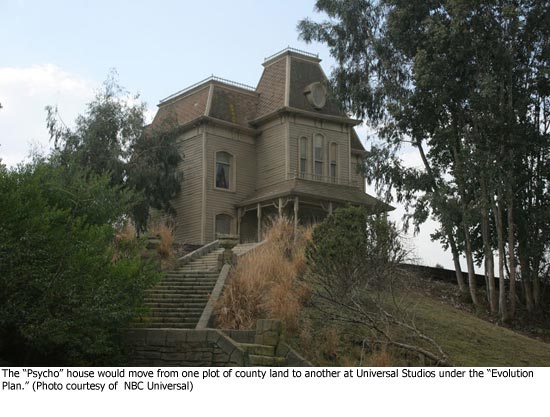

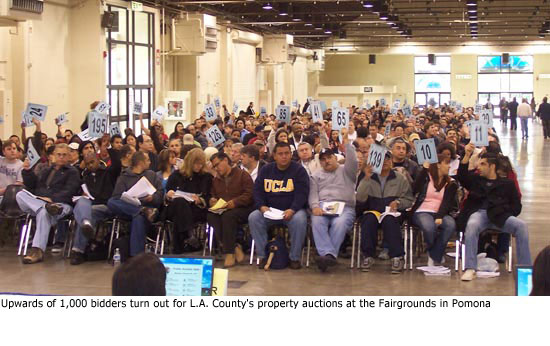







 405 bridge work causes a stink
405 bridge work causes a stink
